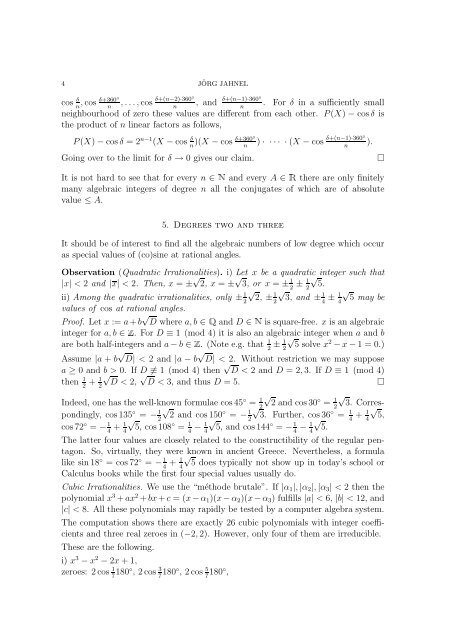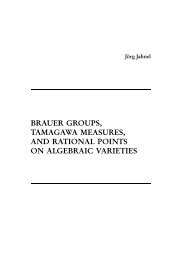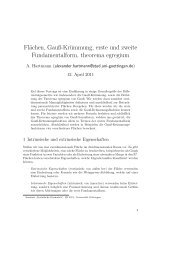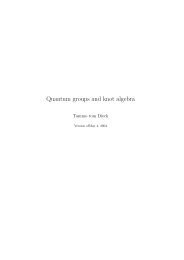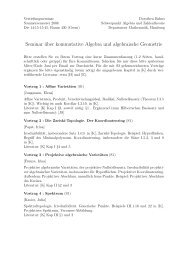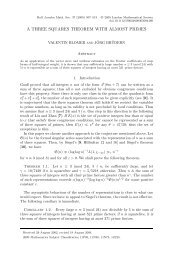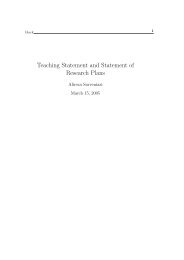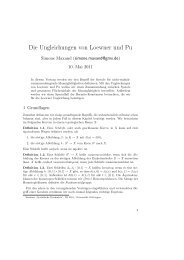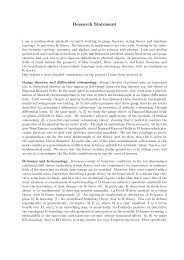SINE OF A RATIONAL ANGLE EQUAL TO A RATIONAL NUMBER?
SINE OF A RATIONAL ANGLE EQUAL TO A RATIONAL NUMBER?
SINE OF A RATIONAL ANGLE EQUAL TO A RATIONAL NUMBER?
You also want an ePaper? Increase the reach of your titles
YUMPU automatically turns print PDFs into web optimized ePapers that Google loves.
4 JÖRG JAHNEL<br />
cos δ δ+360◦<br />
, cos , . . .,cos δ+(n−2)·360◦ , and δ+(n−1)·360◦ . For δ in a sufficiently small<br />
n n<br />
n<br />
n<br />
neighbourhood of zero these values are different from each other. P(X) − cosδ is<br />
the product of n linear factors as follows,<br />
P(X) − cos δ = 2 n−1 (X − cos δ n<br />
Going over to the limit for δ → 0 gives our claim.<br />
δ+360◦<br />
)(X − cos ) · · · · · (X − cos δ+(n−1)·360◦ ).<br />
n<br />
n<br />
It is not hard to see that for every n ∈Æand every A ∈Êthere are only finitely<br />
many algebraic integers of degree n all the conjugates of which are of absolute<br />
value ≤ A.<br />
□<br />
5. Degrees two and three<br />
It should be of interest to find all the algebraic numbers of low degree which occur<br />
as special values of (co)sine at rational angles.<br />
Observation (Quadratic Irrationalities). i) Let x be a quadratic integer such that<br />
|x| < 2 and |x| < 2. Then, x = ± √ 2, x = ± √ 3, or x = ± 1 ± 1 2 2√<br />
5.<br />
√<br />
ii) Among the quadratic irrationalities, only ± 2√ 1 2, ±<br />
1<br />
2 3, and ±<br />
1<br />
± 1 4 4√<br />
5 may be<br />
values of cos at rational angles.<br />
Proof. Let x := a+b √ D where a, b ∈Éand D ∈Æis square-free. x is an algebraic<br />
integer for a, b ∈. For D ≡ 1 (mod 4) it is also an algebraic integer when a and b<br />
are both half-integers and a − b ∈. (Note e.g. that 1 2 ± 1 2√<br />
5 solve x 2 − x − 1 = 0.)<br />
Assume |a + b √ D| < 2 and |a − b √ D| < 2. Without restriction we may suppose<br />
a ≥ 0 and b > 0. If D ≢ 1 (mod 4) then √ D < 2 and D = 2, 3. If D ≡ 1 (mod 4)<br />
then 1 2 + 1 2√<br />
D < 2,<br />
√<br />
D < 3, and thus D = 5. □<br />
Indeed, one has the well-known formulae cos 45 ◦ = 1 2√<br />
2 and cos 30 ◦ = 1 2√<br />
3. Correspondingly,<br />
cos 135 ◦ = − 1 2√<br />
2 and cos 150 ◦ = − 1 2√<br />
3. Further, cos 36 ◦ = 1 4 + 1 4√<br />
5,<br />
cos 72 ◦ = − 1 4 + 1 4√<br />
5, cos 108 ◦ = 1 4 − 1 4√<br />
5, and cos 144 ◦ = − 1 4 − 1 4√<br />
5.<br />
The latter four values are closely related to the constructibility of the regular pentagon.<br />
So, virtually, they were known in ancient Greece. Nevertheless, a formula<br />
like sin 18 ◦ = cos 72 ◦ = − 1 4 + 1 4√<br />
5 does typically not show up in today’s school or<br />
Calculus books while the first four special values usually do.<br />
Cubic Irrationalities. We use the “méthode brutale”. If |α 1 |, |α 2 |, |α 3 | < 2 then the<br />
polynomial x 3 +ax 2 +bx+c = (x −α 1 )(x −α 2 )(x −α 3 ) fulfills |a| < 6, |b| < 12, and<br />
|c| < 8. All these polynomials may rapidly be tested by a computer algebra system.<br />
The computation shows there are exactly 26 cubic polynomials with integer coefficients<br />
and three real zeroes in (−2, 2). However, only four of them are irreducible.<br />
These are the following.<br />
i) x 3 − x 2 − 2x + 1,<br />
zeroes: 2 cos 1 7 180◦ , 2 cos 3 7 180◦ , 2 cos 5 7 180◦ ,


